More Bark than Bite: Analysis of the Layers of a Spider Web
 Jan 11, 2016 • 8:30 PM UTC
Jan 11, 2016 • 8:30 PM UTC Unknown Location
Unknown Location 140x Magnification
140x Magnification Unknown
Unknown
ouzosike
Learn about the author...
1posts
0comments
1locations
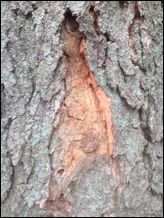
My partner and I were working with the foldscope, brainstorming project ideas, and using it to image random objects we found in the area when we both happened to notice the same tree. There was nothing particularly striking about this tree compared to any other, but we started to wonder what is happening on, and in the tree on a smaller level. This is not something one usually thinks about as they walk past trees on campus, because we are in a rush to our next destination and trees are just part of the scenery on the way. They are stationary, and so we assume that nothing particularly interesting or exciting could be happening to a tree, especially once all the leaves have fallen and it stands bare.
People usually do not pay any particular attention to trees, and people certainly do not pay much attention to the bark, but today we did. Initially we were most taken by the mix of mosses, fungi, and vines that covered the surface of the bark. This proved to be interesting but upon looking around, my partner and I realized that these mosses and vines were ubiquitous to the surfaces around us—not just the tree, so we decided to look for something a little more unique. We decided it would be especially interesting to look under the bark of the tree. As my partner and I worked, we decided to remove a strange looking segment of the bark and discovered a spider web just under the surface.
People usually do not pay any particular attention to trees, and people certainly do not pay much attention to the bark, but today we did. Initially we were most taken by the mix of mosses, fungi, and vines that covered the surface of the bark. This proved to be interesting but upon looking around, my partner and I realized that these mosses and vines were ubiquitous to the surfaces around us—not just the tree, so we decided to look for something a little more unique. We decided it would be especially interesting to look under the bark of the tree. As my partner and I worked, we decided to remove a strange looking segment of the bark and discovered a spider web just under the surface.
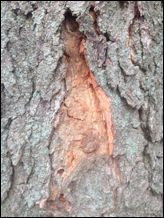
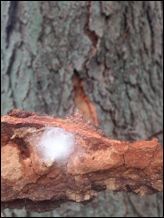
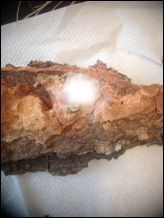
Once we found this ‘web’, we immediately decided to explore it using the foldscope. We wanted to observe what the web looked like close up, and we had noticed that it seemed to be made up of distinct layers—so we also wanted to see if there were differences in the structure of the web, depending on the layer.
Neither my partner, nor I, expected anything to inhabit this little webbed-sack—after all it is the middle of winter, but after removing the first layer of the web it became apparent that there was a spider inside. Initially we were a little startled by our discovery, but we managed to release the spider and carry out our analysis of the web.
Outer-most layer:
Neither my partner, nor I, expected anything to inhabit this little webbed-sack—after all it is the middle of winter, but after removing the first layer of the web it became apparent that there was a spider inside. Initially we were a little startled by our discovery, but we managed to release the spider and carry out our analysis of the web.
Outer-most layer:
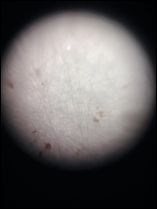
Middle layer:
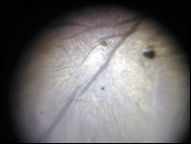
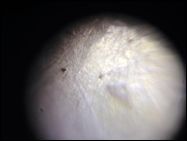
Inner-most Layer
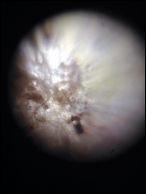
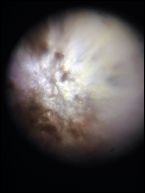
Although structurally there did not appear to be any distinction between the layers, we did notice a lot more debris in the webbing as we approached the inside of the web-sack. Although we are not certain why this was, we proposed that the spider might have brought in this debris as it went out and returned in search of food (or some other type of waste). Of course when one imagines a spider web it is white and pristine, but in actuality it is quite common to the web covered in debris and refuse—not only from the spider, but also from the environment and prey that got has gotten stuck. Of course, this did not seem like a typical spider web, and because it was a completely sealed sack when we found it, we theorized that any debris on the inside of the web must be directly from the spider itself or else brought in by the spider at some earlier time.
Although we did not place the spider under the eye of our foldscope, we were able to identify it as Salticus scenicus —the common zebra jumping spider. Upon doing a little research, found that this species does not typically build webs for hunting, but rather stalks and attacks its prey. Given this new information we posited that this web structure must not be for any type of prey-capture, but might instead be a home that the spider has created for itself to wait out the long Princeton winter—a hypothesis that was corroborated by orkin.com (a pest extermination site of all places!).
Although we did not place the spider under the eye of our foldscope, we were able to identify it as Salticus scenicus —the common zebra jumping spider. Upon doing a little research, found that this species does not typically build webs for hunting, but rather stalks and attacks its prey. Given this new information we posited that this web structure must not be for any type of prey-capture, but might instead be a home that the spider has created for itself to wait out the long Princeton winter—a hypothesis that was corroborated by orkin.com (a pest extermination site of all places!).
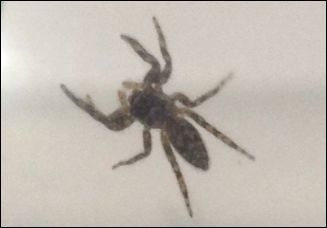
Nowadays it seems that humans have had at least some level of interaction with just about every species and every ecological system out there, whether it be know and intentional or not. Such is the case with Salticus scenicus —a species that seems to be most common around urban areas (spiders.us.com). In our situation, the spider nest was found in the heart of campus, under the protection of a layer of bark. It is not all that often that you hear about how urban sprawl and the land development has beneficially impacted species, so our discovery about this species being most common in human-inhabited areas left us curious. What is it about the human environment that is attractive to these species? Is it all the human-produced garbage? Is it the open space or the concrete and metal structures? Could it be the human presence itself? Neither of us are quite sure where our relationship with the sciences will take us, but we hope that someday we will get a chance to return to the questions that were initially prompted by our fiddling with the foldscope.
We completed this project as part of Dr. Pringle’s EEB321 course at Princeton University
Maechi and Nathan
Works cited:
“Salticus Scenicus (Zebra Jumper).” Spidersus Salticus Scenicus Comments . Spiders.us, 11 Mar. 2014. Web. 11 Jan. 2016.
“Zebra Jumping Spiders – Orkin.” Orkin . Orkin LLC, 2015. Web. 11 Jan. 2016.
We completed this project as part of Dr. Pringle’s EEB321 course at Princeton University
Maechi and Nathan
Works cited:
“Salticus Scenicus (Zebra Jumper).” Spidersus Salticus Scenicus Comments . Spiders.us, 11 Mar. 2014. Web. 11 Jan. 2016.
“Zebra Jumping Spiders – Orkin.” Orkin . Orkin LLC, 2015. Web. 11 Jan. 2016.
Sign in to commentNobody has commented yet... Share your thoughts with the author and start the discussion!
More Posts from ouzosike
No more posts from this author.